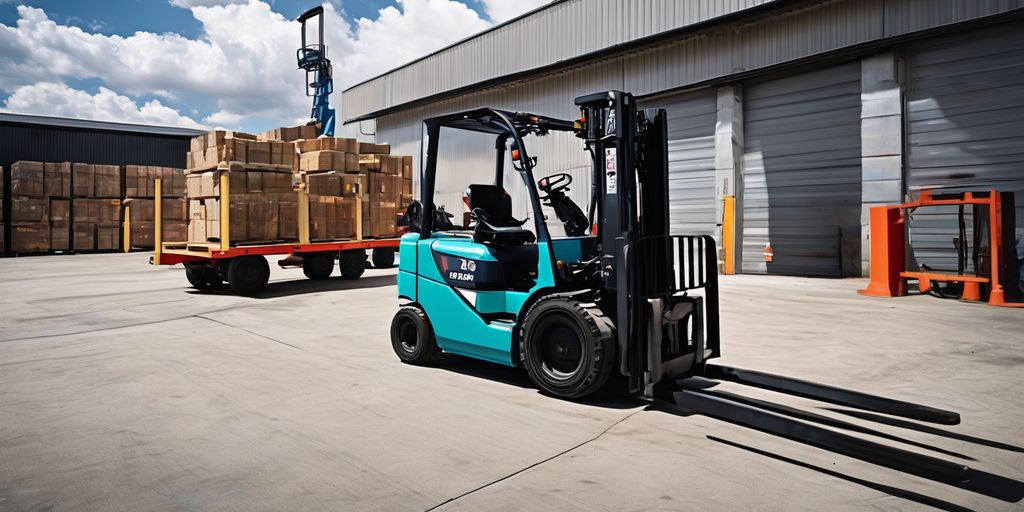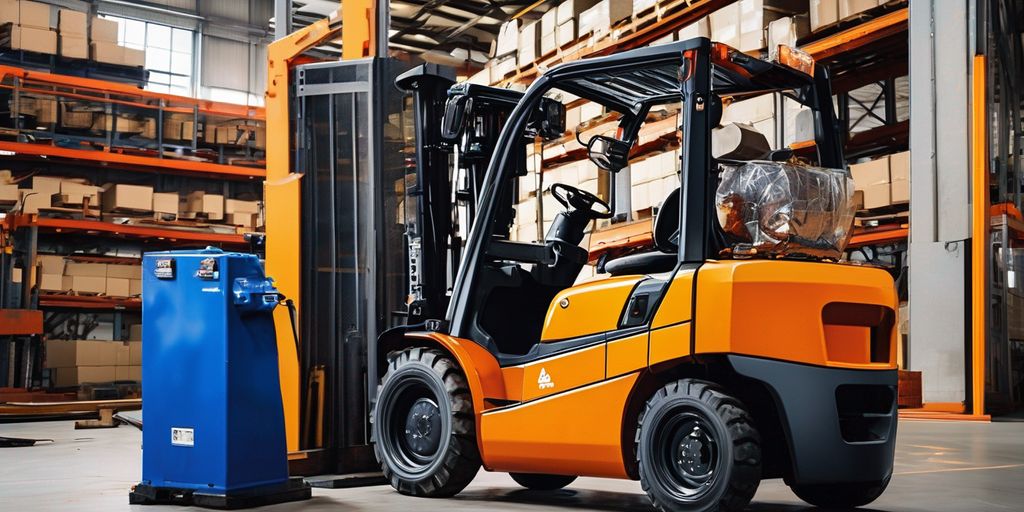Finding the right forklift parts is crucial for maintaining the efficiency and safety of your forklift operations. Whether you're a seasoned professional or new to the field, understanding the different types of parts, knowing how to identify them, and sourcing them from reliable suppliers can make all the difference. This comprehensive guide aims to provide you with all the essential information you need to keep your forklifts running smoothly and efficiently.
Key Takeaways
- Understand the different types of forklift parts, including engine components, hydraulic systems, and electrical parts.
- Use various methods such as checking part numbers, consulting the manual, and using online resources to identify the right forklift parts.
- Source quality forklift parts from authorized dealers, online retailers, and local suppliers.
- Ensure compatibility and safety by verifying load capacity, ensuring part compatibility, and following installation guidelines.
- Implement cost-effective strategies like buying in bulk, comparing prices, and opting for refurbished parts to save money on forklift parts.
Understanding Different Types of Forklift Parts
Forklifts are complex machines with numerous components working together to ensure efficient and safe operations. Understanding the essential parts of a forklift truck is crucial for maintenance and troubleshooting. This section will explore the primary categories of forklift parts, providing a comprehensive guide on their functions and importance.
Engine Components
The engine is the heart of the forklift, powering all its functions. Key engine components include:
- Engine Block: The main structure housing the cylinders and other engine parts.
- Pistons: Convert fuel into mechanical energy.
- Crankshaft: Transforms the pistons' linear motion into rotational motion.
- Fuel System: Includes the fuel tank, pump, and injectors, ensuring a steady fuel supply.
Hydraulic Systems
Hydraulic systems are vital for lifting and moving loads. They consist of:
- Hydraulic Pump: Generates the necessary pressure to lift loads.
- Cylinders: Convert hydraulic pressure into mechanical force.
- Valves: Control the flow and direction of hydraulic fluid.
- Hoses and Fittings: Transport hydraulic fluid between components.
Electrical Parts
Electrical components are essential for the forklift's operation and safety. Important electrical parts include:
- Battery: Powers the electrical system and starts the engine.
- Alternator: Charges the battery and powers electrical systems when the engine is running.
- Starter Motor: Initiates the engine's operation.
- Control Panel: Houses switches and indicators for various functions.
A comprehensive guide on forklift parts, power sources, mast functions, and maintenance is essential for efficient and safe operations.
How to Identify the Right Forklift Parts
Identifying the right forklift parts is crucial for maintaining the efficiency and productivity of your operations. By following these guidelines, you should have no trouble getting the exact replacement parts that will keep your machine running smoothly for years to come.
Checking Part Numbers
The first step in finding the correct parts is to check the part numbers. These numbers are usually found on the part itself or in the forklift's manual. Make sure to match these numbers accurately to avoid any compatibility issues.
Consulting the Manual
Your forklift's manual is an invaluable resource when it comes to identifying parts. It provides detailed information about each component, including part numbers and specifications. Always refer to the manual before making any purchase decisions.
Using Online Resources
There are numerous online resources available that can help you identify the right parts for your forklift. Websites often offer comprehensive guides and databases where you can search for parts by model and make. This can be particularly useful if you don't have immediate access to the manual.
For a comprehensive guide on choosing the right forklift for business efficiency and productivity, considering operational needs, fuel options, and new vs. used, check out our detailed articles.
By leveraging these methods, you can ensure that you are getting the right parts for your forklift, thereby maintaining its performance and longevity.
Where to Source Quality Forklift Parts
When it comes to sourcing quality forklift parts, there are several reliable options to consider. Finding the right supplier can make a significant difference in the performance and longevity of your forklift. Here are some of the best places to look for high-quality components:
Authorized Dealers
Authorized dealers are often the best source for genuine forklift parts. They have direct access to the manufacturer's inventory, ensuring that you get parts that are specifically designed for your forklift model. Additionally, authorized dealers often provide warranties and expert support, which can be invaluable.
Online Retailers
Online retailers offer a convenient way to shop for forklift parts. Websites like Wholesale Industrial Parts provide a wide range of options, competitive pricing, and fast shipping. It's essential to read customer reviews and check the retailer's reputation before making a purchase.
Local Suppliers
Local suppliers can be a great option if you need parts quickly. They often have a wide range of inventory, so if you’re looking for something specific, it’s worth checking out what they offer. Local suppliers can also provide personalized service and immediate support.
Conduct thorough research and consider factors such as the supplier’s experience, reputation, customer reviews, and the range of parts they offer. Look for suppliers with a proven track record of providing high-quality forklift parts.
By exploring these options, you can find the right parts to keep your forklift operating smoothly and efficiently.
Tips for Ensuring Compatibility and Safety
Ensuring the compatibility and safety of forklift parts is crucial for maintaining a secure and efficient working environment. Here are some essential tips to help you achieve this goal.
Verifying Load Capacity
Before installing any new parts or accessories, it's vital to verify the load capacity. Using parts that do not meet the required load capacity can lead to dangerous situations. Always refer to the manufacturer's specifications to ensure that the parts are suitable for your forklift's load requirements.
Ensuring Part Compatibility
Compatibility is key when it comes to forklift parts. Some manufacturers use proprietary designs that are incompatible with other brands. To avoid costly mistakes, check with your dealer or supplier for product compatibility before making a purchase. This ensures that the part or accessory will fit correctly and operate safely.
Following Installation Guidelines
Proper installation is essential for the safe operation of your forklift. Make sure to follow the manufacturer's installation guidelines meticulously. Improper installation can compromise the safety and efficiency of your forklift. If you're unsure about the installation process, it's always best to consult a professional.
By using the right accessories, you can enhance the performance of your forklift and ensure a safer working environment for operators and those around them.
Maintaining Your Forklift for Longevity
Regular Maintenance Checks
Expert forklift maintenance is essential for safety and efficiency. Regular checks, qualified partners, and seasonal maintenance are key. Prevent downtime and ensure peak performance for cost savings.
Proper Storage Practices
Proper storage practices are crucial for maintaining the longevity of your forklift. Ensure that forklifts are stored in a dry, clean environment to prevent rust and other damage. Regularly inspect storage areas for potential hazards.
Timely Replacements
Performing periodic replacement will help you maintain the long-term value of your forklift and maximize your ROI, avoiding unnecessary breakdowns. It will also help your operation by ensuring you can schedule maintenance effectively by judging what changes will take longer.
Expert forklift maintenance: essential steps for peak performance. Importance of regular maintenance, choosing right partners, common issues, and OSHA compliance. Key takeaways for efficient and safe operations.
Cost-Effective Strategies for Forklift Parts
Buying in Bulk
Purchasing forklift parts in bulk can lead to significant savings. Bulk buying often comes with discounts that reduce the overall cost per unit. This strategy is particularly useful for parts that have a high turnover rate or are frequently needed for maintenance.
Comparing Prices
Before making a purchase, it's essential to compare prices from different suppliers. Utilize online resources and consult multiple vendors to ensure you're getting the best deal. This approach not only helps in finding the most competitive prices but also provides insights into the market standards.
Opting for Refurbished Parts
Refurbished parts can be a cost-effective alternative to new ones. These parts are often restored to like-new condition and can offer reliable performance at a fraction of the cost. However, it's crucial to verify the quality and warranty terms before making a purchase.
Managing forklift maintenance costs: tips for budget-friendly solutions. Investing in comprehensive maintenance plans, cost-effective purchase strategies, and prioritizing training and awareness for forklift operators can reduce expenses and enhance safety.
Common Mistakes to Avoid When Buying Forklift Parts

Ignoring Manufacturer Recommendations
One of the most common mistakes is ignoring the manufacturer's recommendations. These guidelines are designed to ensure the optimal performance and safety of your forklift. Overlooking them can lead to improper installations and potentially hazardous situations.
Overlooking Warranty Terms
When purchasing forklift parts, it's crucial to pay attention to the warranty terms. Failing to do so can result in unexpected costs if the parts fail prematurely. Always check the warranty coverage and understand the conditions to avoid any surprises.
Skipping Professional Advice
Many buyers make the mistake of not seeking professional advice. Consulting with experts can help you identify the right parts and avoid common pitfalls. Professional guidance is invaluable, especially when dealing with complex components like hydraulic systems or electrical parts.
Proper inspection and maintenance history are key factors to consider when purchasing forklift parts. This ensures you make a wise investment for reliable material handling equipment.
Highlights
- Ignoring the manufacturer's recommendations can lead to improper installations and hazardous situations.
- Failing to pay attention to warranty terms can result in unexpected costs.
- Not seeking professional advice can lead to poor decisions, especially with complex components.
Conclusion
In conclusion, maintaining your forklift fleet in optimal condition is crucial for the smooth operation of your business. By understanding the different types of forklift parts, knowing where to source them, and following proper installation and maintenance procedures, you can ensure that your forklifts remain reliable and efficient. This guide has provided you with the essential information needed to navigate the complexities of forklift parts supply and repair. With careful planning and the right resources, you can minimize downtime and keep your operations running smoothly. Remember, investing time in finding the right parts and maintaining your equipment will pay off in the long run, ensuring safety and productivity in your material handling tasks.
Frequently Asked Questions
What are the most common types of forklift parts?
The most common types of forklift parts include engine components, hydraulic systems, and electrical parts. Each type plays a crucial role in the operation of the forklift.
How can I identify the right forklift part for my machine?
You can identify the right forklift part by checking the part numbers, consulting the manual, and using online resources. These methods will help ensure you get the exact replacement part needed.
Where can I source quality forklift parts?
Quality forklift parts can be sourced from authorized dealers, online retailers, and local suppliers. Each source has its own advantages and can provide reliable parts for your forklift.
What should I consider to ensure compatibility and safety of forklift parts?
To ensure compatibility and safety, verify the load capacity, ensure part compatibility with your existing unit, and follow the installation guidelines carefully.
Why is regular maintenance important for forklifts?
Regular maintenance checks, proper storage practices, and timely replacements are essential for maintaining the longevity and efficiency of your forklift. These practices help prevent breakdowns and extend the life of the machine.
What are some cost-effective strategies for buying forklift parts?
Cost-effective strategies for buying forklift parts include buying in bulk, comparing prices from different suppliers, and opting for refurbished parts. These approaches can help you save money without compromising on quality.




Leave a comment
This site is protected by hCaptcha and the hCaptcha Privacy Policy and Terms of Service apply.